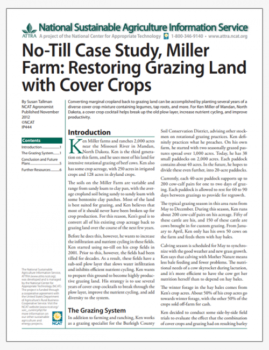No-Till Case Study, Miller Farm: Restoring Grazing Land with Cover Crops
By Susan Tallman, NCAT Agronomist
Abstract
Converting marginal cropland back to grazing land can be accomplished by planting several years of a diverse cover crop mixture containing radish, turnip, and sunflower. For Ken Miller of Mandan, North Dakota, a cover crop cocktail helps break up the old plow layer, increase nutrient cycling, and improve productivity.
Contents
Introduction
The Grazing System
Conclusion and Future Plans
Further Resources
Introduction
Ken Miller farms and ranches 2,000 acres near the Missouri River in Mandan, North Dakota. Ken is the third generation on this farm, and he uses most of his land for intensive rotational grazing of beef cows. Ken also has some crop acreage, with 250 acres in irrigated crops and 128 acres in dryland crops.
The soils on the Miller Farm are variable and range from sandy loam to clay pan, with the average cropland soil being sandy to sandy loam with some bentonite clay patches. Most of the land is best suited for grazing, and Ken believes that most of it should never have been broken up for crop production. For this reason, Ken’s goal is to convert all of his existing crop acreage back to grazing land over the course of the next few years.
Before he does this, however, he wants to increase the infiltration and nutrient cycling in these fields. Ken started using no-till on his crop fields in 2001. Prior to this, however, the fields had been tilled for decades. As a result, these fields have a sub-soil plow layer that slows water infiltration and inhibits efficient nutrient cycling. Ken wants to prepare this ground to become highly productive grazing land. His strategy is to use several years of cover crop cocktails to break through the plow layer, improve the nutrient cycling, and add diversity to the system.
The Grazing System
In addition to farming and ranching, Ken works as a grazing specialist for the Burleigh County Soil Conservation District, advising other stockmen on rotational grazing practices. Ken definitely practices what he preaches. On his own farm, he started with two seasonally grazed pastures spread over 1,000 acres. Today, he has 38 small paddocks on 2,000 acres. Each paddock contains about 40 acres. In the future, he hopes to divide these even further, into 20-acre paddocks.
Currently, each 40-acre paddock supports up to 200 cow-calf pairs for one to two days of grazing. Each paddock is allowed to rest for 60 to 90 days between grazings to provide for regrowth.
The typical grazing season in this area runs from May to December. During this season, Ken runs about 200 cow-calf pairs on his acreage. Fifty of these cattle are his, and 150 of these cattle are cows brought in for custom grazing. From January to April, Ken only has his own 50 cows on the farm and feeds them with hay bales.
Calving season is scheduled for May to synchronize with the good weather and new grass growth. Ken says that calving with Mother Nature means less bale feeding and fewer problems. The nutritional needs of a cow skyrocket during lactation, and it’s more efficient to have the cow get her nutrition herself than to depend on hay bales.
The winter forage in the hay bales comes from Ken’s crop acres. About 50% of his crop acres go towards winter forage, with the other 50% of the crops sold off-farm for cash.
Table 1. Monthly precipitation 2005-2009, Mandan, North Dakota
| Month | 2005 | 2006 | 2007 | 2008 | 2009 |
| J | .18 | .07 | .13 | .08 | .79 |
| F | .07 | .14 | .62 | .36 | .57 |
| M | .35 | .36 | 1.06 | .45 | 1.48 |
| A | .16 | .95 | .67 | .55 | 1.13 |
| M | 2.63 | 1.79 | 5.19 | 1.59 | 2.13 |
| J | 6.00 | .93 | 4.67 | 4.88 | 6.93 |
| J | 4.64 | .57 | 1.42 | 2.52 | 3.47 |
| A | 2.42 | 1.79 | 4.45 | .90 | .83 |
| S | .35 | 1.62 | 1.61 | 1.56 | 1.73 |
| O | 1.23 | 1.58 | .50 | 1.80 | 2.54 |
| N | .74 | .05 | .07 | 3.68 | 0.00 |
| D | .52 | .68 | .16 | 1.81 | .82 |
| TOTAL | 19.29 | 10.53 | 20.55 | 20.18 | 22.42 |
Source: NOAA, Mandan Experiment Station, North Dakota

Miller Farm North and South Fields for Cover Crop Comparison. Photo: Ken Miller
Ken decided to conduct some side-by-side field trials to evaluate the effect that the combination of cover crops and grazing had on resulting barley crops. He split some of his dryland crop acres into a North Field and a South Field. The North Field had 22 acres, and the adjacent South Field had 24 acres. Ken decided to use cover crop cocktails and grazing on both fields in 2006. In 2007, he compared South Field’s cover crop cocktail and grazing to the North Field’s performance without a cover crop cocktail. (Table 2 lists the field histories.)
In 2005, prior to the field trial, the North Field had been in alfalfa for eight years. This alfalfa was sprayed with glyphosate in the fall to terminate it. In 2005, Ken grew a crop of yellow field peas in the South Field. The crop was hailed out that year in early July, but Ken hayed the remaining biomass at a yield of 1.2 tons per acre. He also spread manure on the South Field that fall at a rate of eight to 10 tons per acre. No manure was spread on the North Field.
Table 2. Field History Summary
| Year | North Field | South Field |
| 2005 | Alfalfa | Yellow field pea |
| 2006 | Oats/turnip/ryegrass for grazing | Oats/turnip/ryegrass for grazing
Winter triticale — fall seeding |
| 2007 | Malt barley—April to July | Grazed triticale
Cover crop —August seeding |
| 2008 | Malt barley —April to July
Cover crop – August seeding |
Malt barley—April to July
Cover crop — August seeding |
| 2009 | Corn | Corn |
Ken planted his first cover crop cocktail on April 26, 2006, on both the North Field and South Field. This cocktail was a three-way mixture of oats, turnips, and annual ryegrass. As it happened, 2006 was a drought year, with only 10.53 inches of precipitation. Because of the drought, kochia weeds were able to compete with the cover crop. Rather than use herbicide, Ken grazed 145 cows for three days to control the weed growth in mid-June. Because of the drought, only weeds re-grew in the field.
In September 2006, Ken planted winter triticale in the South Field. He used triticale instead of cereal rye because it puts on about the same amount of biomass, but is more palatable for grazing. Also, there is less of a volunteer weed problem with triticale than with cereal rye.
Ken divided the South Field of triticale into three separate grazing paddocks with electric fence. Two paddocks were nine acres each, and one paddock was four acres. He started grazing the triticale in the spring of 2007 and was able to graze 135 cow-calf pairs in each paddock three times; once each in May, June, and July. Ken allowed the cows to graze each triticale paddock for two to three days at a time before moving them to irrigated grass pastures. At each triticale grazing, the cattle grazed off about 50% of the triticale biomass.
Table 3. Triticale Grazing Schedule, 2007
| Date | Grazing Details |
| May 9 – 17 | Grazed when triticale was six to eight inches tall. Some paddocks grazed down to two inches, others grazed down to four inches. |
| June 9 – 18 | Grazed when triticale was three feet tall and heading out. |
| July 10 – 17 | Grazed when triticale was starting to ripen. Animals trampled the crop. |
Then, on August 2, 2007, Ken planted a multi-species cover crop cocktail in the South Field after the triticale had been sprayed with glyphosate. His cocktail consisted of the species listed in Table 4.
Table 4. Miller Cover Crop Cocktail, 2007, South Field
| Species | Plant Type | Est. Seeding Rate (lb/acre) |
| Soybean | Legume | 15 |
| Cowpea | Legume | 10 |
| Millet | Warm season, grass | 7 |
| Turnip | Cool season, Brassica | 1 |
| Radish | Cool season, Brassica | 1 |
| Sunflower | Warm season, broadleaf | 1 |
| Yellow Blossom Sweet Clover | Legume | 1 |
By late September, the millet and sunflower had set heads and Ken grazed the South Field for 10 days by rotating the cattle through the three paddocks. The cover crop put on some regrowth after the grazing, and Ken was able to graze it a second time in December.
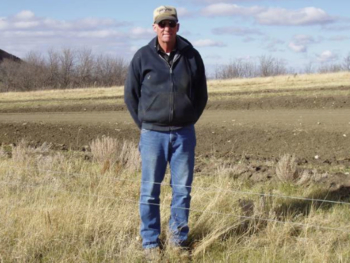
Ken Miller on the Miller Farm. Photo: Jay Fuhrer, NRCS
Both times, Ken allowed the grazing cows to take half of the biomass. He left the other half of the biomass to improve the soil health. The photo illustrates that no bare soil was visible through the cover crop residue after grazing.
After the December grazing, the cover crop winterkilled. From November 2007 to April 2008, the Mandan area had very little moisture. Only 1.67 inches of precipitation fell during this time.
In contrast to the South Field, the North Field did not have a crop of winter triticale in 2006. The North Field had an oat/turnip/ryegrass cover crop in 2006 that was terminated by grazing. No herbicide was applied afterwards. Instead, in the spring of 2007, Ken planted a malt barley cash crop (cv. Steller) in the North Field. The barley was harvested on July 22 with a yield of 40 bushels per acre.
In 2008, Ken was able to compare the effects of the cover crop cocktails and grazing on the following malt barley crop. He planted a crop of spring malt barley in both the South Field (cover crop and grazing) and North Field (no cover crop, no grazing) on April 20, 2008. Before planting, Ken took a soil sample in each field to determine the available N. The South Field tested at 180 pounds of available N, while the North Field tested at only 20 pounds of available N. Ken applied 100 pounds per acre of urea (46-0-0) and 50 pounds per acre of starter fertilizer (12-34-5-6-) on the North Field to address its low fertility. He applied no fertilizer in the South Field because he was curious to see how the barley would perform.
Before planting, Ken also sampled the soil moisture in the South Field. Recall that the winter had very little precipitation, so very little moisture was available in the soil. While testing for moisture, Ken found the first three inches to be very hard, with no moisture, and at nine inches the probe stopped completely.
The difference between the two barley crops was quite significant, with the South Field crop having more lush growth and better yield. Ken made observations of the two fields during the growing season that appear in Table 5.
Table 5. Malt Barley Comparison 2008
| Date | North Field
(No cover crop) |
South Field
(Cover crop) |
| June 1 | Leaves noticeably yellow;
moisture stressed; old crop residue still noticeable |
Green, lush growth;
no drought stress; old crop residue starting to decompose |
| June 23 | Noticeably thicker stand than the North Field | |
| July 7 | Beginning to ripen | Still filling the grain |
| July 27 | Harvest. 60 to 65 bu/acre
Did not meet malt quality specs. |
Harvest. 80 – 85 bu/acre
Met malt quality specs. |
| Aug 2 | Planted cover crop | Planted cover crop |
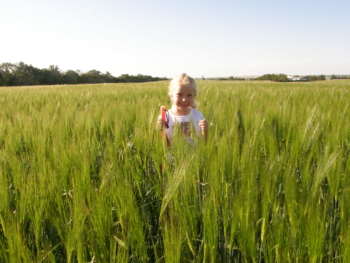
Barley from North Field 2008. Photo: Ken Miller
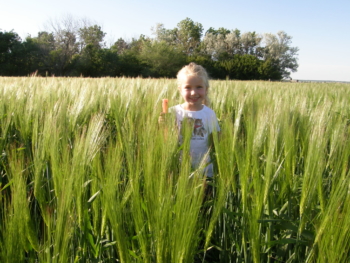
Barley from South Field 2008. Photo: Ken Miller
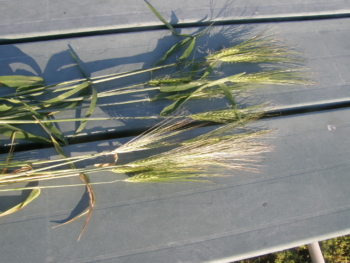
Barley from South Field (top) and North Field (bottom). Photo: Ken Miller
Ken harvested both fields on July 27 in order to make way for an early August planting of a cover crop cocktail on both fields. The moisture content of the grain was about 20%, so he finished the drying with a bin drying system. He did end up blending the barley from the North Field and the South Field so that the entire crop would meet the malt barley contract specs. Without the blending, the North Field barley would not have met the specifications. After the barley harvest, Ken applied glyphosate for weed control, and then planted the same cover crop mixture on both fields that he had planted on the South Field in 2007. (See Table 4.) He planted this cover crop on August 2, 2008. The only change he made in the cover crop mix was to increase the amount of sunflower seed from one pound per acre to two pounds per acre. Some volunteer barley also showed up in this cover crop. He grazed this combined field just once, beginning October 1, for three days. He had hoped to graze it again in December, but it was just too dry.
Ken calculated a partial budget for this cover crop and barley trial.
Figure 1. Cover Crop and Barley Trial Budget, 2008
North Field Barley (no cover crop)
Gross Income: 65 bu/acre x $5/bu = $325 per acre
Fertilizer Cost = $44/acre
#100 Urea (46-0-0)
#50 starter fertilizer (12-34-5-6)
Net Return: $281/acre
South Field Barley (cover crop)
Gross Income: 85 bu/acre x $5/bu = $425 per acre
Cover Crop Seeding Cost: $35/acre
Net Return: $390/acre
Difference: $109 per acre
In 2009, Ken planted corn in both the North and South Fields. This corn crop yielded 113 bushels per acre on both fields. He used only starter fertilizer on this crop, and did not side-dress or add any other fertilizers. In addition, he only applied one in-crop application of glyphosate at the 4- to 5-inch stage. Because the cover crop gave him such good control of the weeds, he did not need to do a second in-crop application.
Conclusion and Future Plans
Ken is planning to convert all of his cropland back to perennial grazing pasture. In 2011, he planned to seed all of his 250 acres of irrigated land into pasture. These 250 acres of pasture will be split into 18 small paddocks, each about 13 acres. The 128 dryland acres will also be split, into six small paddocks of about 20 acres each. Both the irrigated and dryland acreage were to be seeded with the mix listed in Table 6.
Table 6. Miller Pasture Species Mix
| Plant Species | Plant Functional Group |
| Cicer milk vetch | Legume |
| Alfalfa | Legume |
| Sanfoin | Legume |
| Red clover | Legume |
| Meadow brome | Grass |
| Intermediate wheat | Grass |
| Newhy wheatgrass | Grass |
| Big bluestem | Grass |
| Sideoats grama | Grass |
| Western wheatgrass | Grass |
Ken used a cover crop cocktail for four years before planting the field back to forage. He believes that using the cover crop cocktails provided real benefits to his grazing land by breaking up the old plow layer and increasing infiltration. Likewise, the legumes in the cocktails added nitrogen to the soil. He would definitely recommend the technique to other ranchers looking to convert old cropland back to grazing land. Although there is a seeding cost ($35 – $40 per acre), this is offset by the forage value provided by the cover crop.
Further Resources
Burleigh County Soil Conservation District
Farming in the 21st Century: Soil Health
No-Till Case Study, Miller Farm: Restoring Grazing Land with Cover Crops
By Susan Tallman, NCAT Agronomist
Published May 2012
© NCAT
IP444
This publication is produced by the National Center for Appropriate Technology through the ATTRA Sustainable Agriculture program, under a cooperative agreement with USDA Rural Development. ATTRA.NCAT.ORG.

